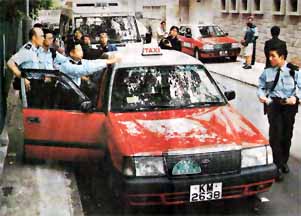Hong Kong Taxis
[Ming Pao via Yahoo! News] About a couple weeks ago, there was a car accident early in the morning in Kowloon. Two taxis and one private vehicle were involved, with some minor scraping involved. When the police arrived at the scene, they found that one of the taxi drivers held a mainland Chinese tourist visa. However, this same person also held a valid Hong Kong driver's license as well as a taxi driver's license. Since the said taxi was not carrying a passenger at the time, the police had to let the driver go since there was no crime.
However, the police did not give up, especially after being hammered in the local press. Investigators from Immigration Control went through the records and saw that this mainlander had multiple entries into Hong Kong where he would rent a taxi from a specific company. Thus, they decided to stake out that company. When the mainlander came on Saturday to take out another taxicab, the investigators followed him. After the mainlander filled up the taxicab at a gas station, the investigators flagged his taxicab down as if they were customers. This allowed them to arrest the mainlander for engaging in business in violation of the terms of his tourist visa.
What are the perils of getting on a taxicab driven by a mainlander, who is nevertheless qualified as a driver? Well, does he know where he is going? For example, does he know where Braga Circuit is?
Fast forward to today's Hong Kong taxi story, which occurred down the street where I live.

There are two taxicabs in this photograph. Something is very wrong here. What? Both of them have the same license plate number: KM 2638.
The precursor event took place last week when a Hong Kong taxi driver was driving around in a taxicab with license plate KM 2638. While taking a fare to Taipo, he saw another taxicab with the identical license plate number. As he moved closer to look, the other driver became alarmed and sped away by weaving dangerously through traffic.
Yesterday, the taxicab driver was driving his father's taxicab and then he saw KM 2638 again on Princess Margaret Road. He followed the other taxicab closely. This time, the other driver was not alarmed because the trailing taxicab had a different license plate. The first taxicab then pulled up at 18 Braga Circuit, when the driver appeared to have stopped to take a nap. The trailing taxicab driver flagged down a police patrol. At first, the KM 2638 driver denied all. He even seemingly had the right papers. Soon, the real KM 2638 arrived at the scene after being hailed on the radio. The police then discovered from the serial number of the fake KM 2638 that it was a stolen vehicle.
What are the perils of getting into a fake taxicab? In the event of an accident, the passengers have no third-person insurance as required by law. This is why the court sentence against operating a "phantom" taxicab is quite severe. In this case, the individual may be charged with driving without a license, having no insurance, illegally operating a commercial vehicle, forging documents, and so on and may have to serve as many as 14 years of jail time.
How many of these "phantom taxicabs" are in operation in Hong Kong? The chairman of the Hong Kong Taxi Drivers Association offered an estimate of about 500. How did this estimate come about, given the known difficulty of estimating the size of any kind of underground economy? When a "phantom taxicab" violates traffic laws, it is the real driver who receives the summons and is then required to pay the fine unless proof can be provided! Unfortunately for passengers, there is no telling whether they are riding a "phanthom taxicab" or not.